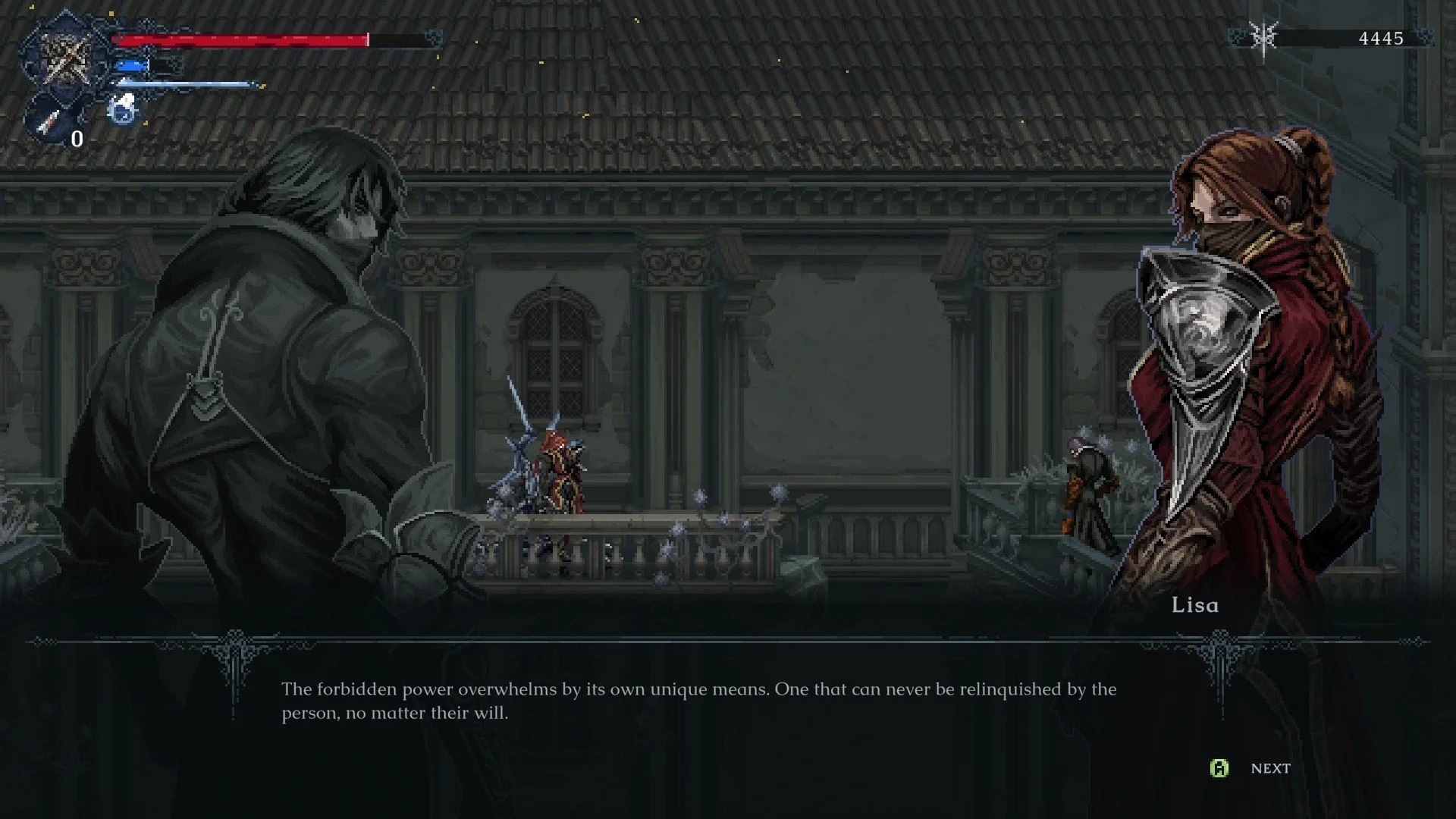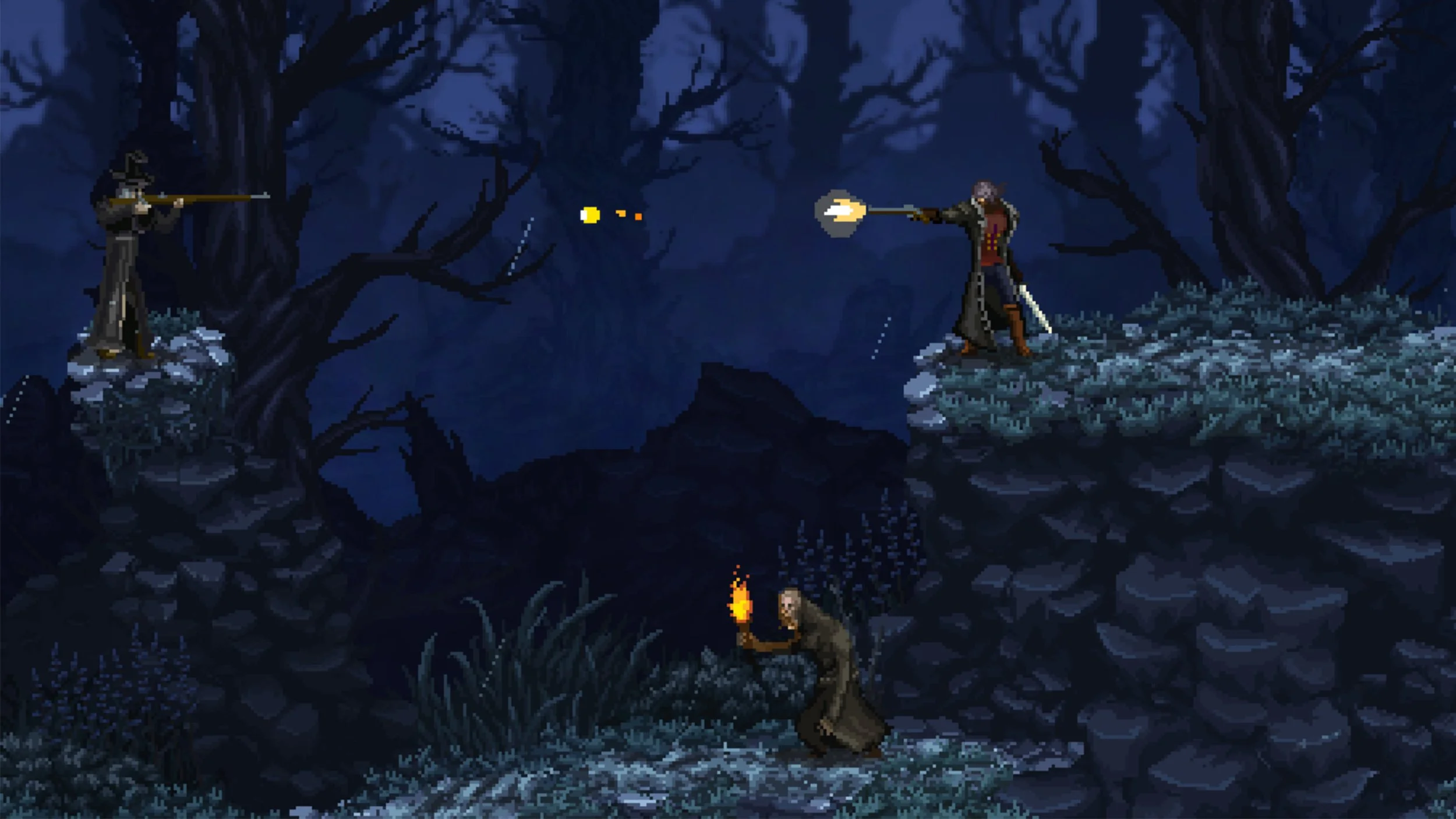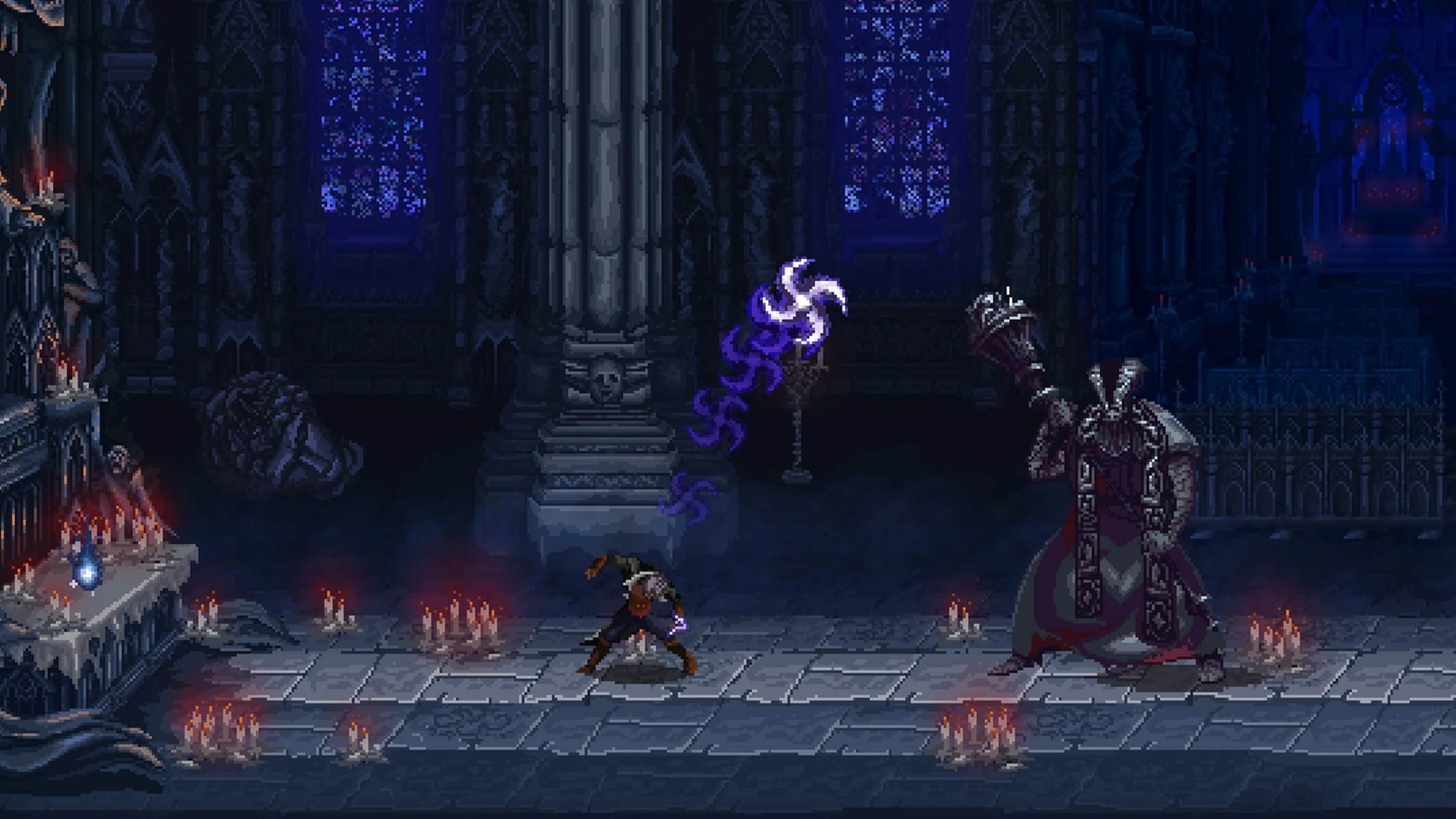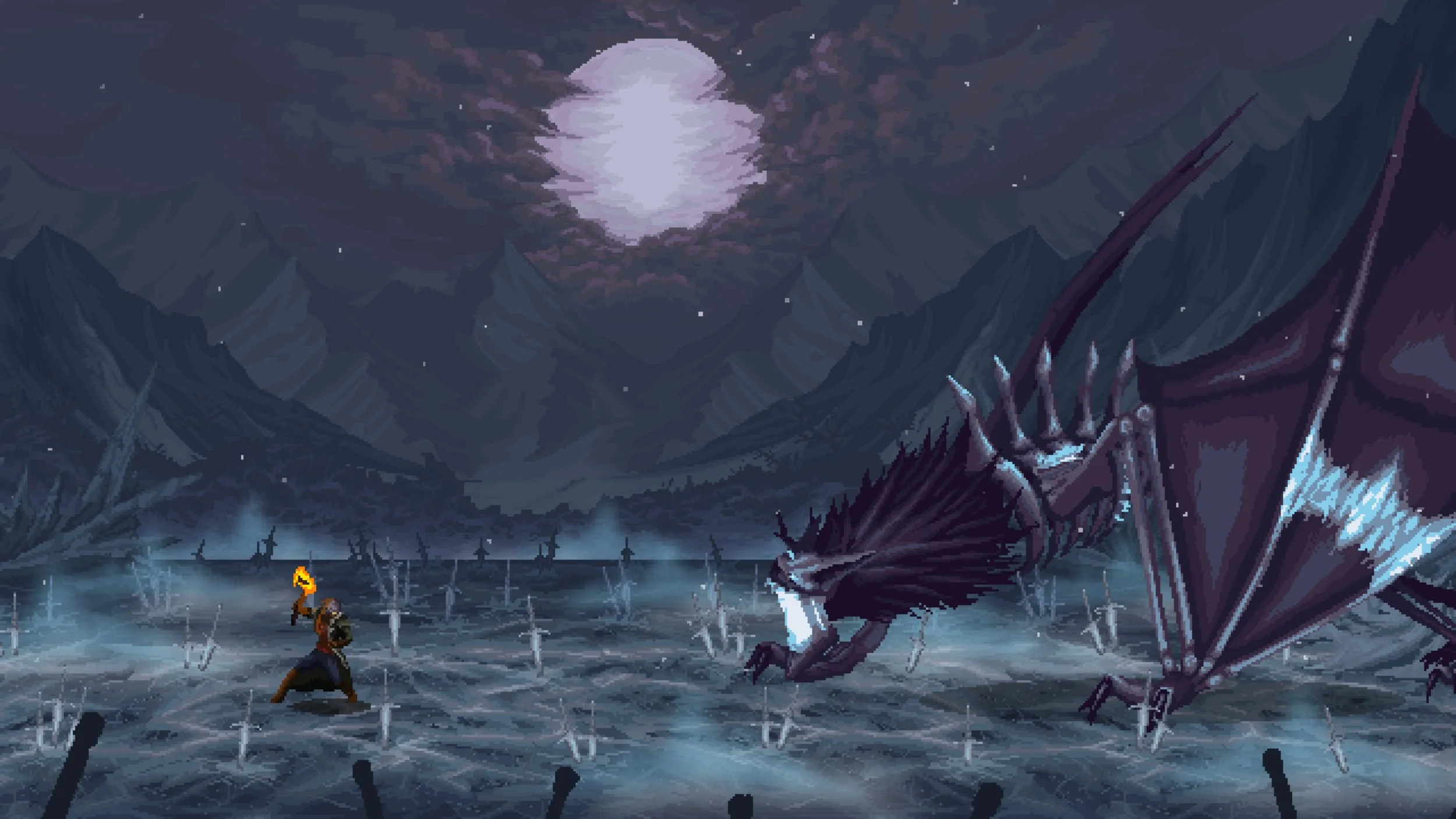The faith shall prevail.
Developer Kumi Souls is certainly one to lean on their inspirations. The Metroidvania genre itself is ripe with some excellent options, especially with a contemporary comparison to Blasphemous and its own sequel that stuck out to me greatly during my 17-hour playthrough. While The Last Faith certainly revels in that mix of both modern and nostalgic, it rarely finds its own unique voice alongside what is essentially a greatest hits of the genre. The game is nonetheless very good, but it rarely is more than that, largely due to some bothersome controls and a bevy of cheap hits.
Nonetheless, the Last Faith has some incredible presentation injected into its 2D pixel-graphic aesthetic. Its dark and morbid Victorian setting alongside the drab caverns and old ruins certainly can make for some gorgeous locales, especially with the scrolling and mixing of several background elements. While some locations tend to wear thin due to a great deal of needless backtracking and similar design elements present in other locations, The Last Faith is nonetheless a stunner when it comes to its look, tone, and feel, often soaked in its macabre and filth across every single pixel.
As a mysterious man named Eryk, you’ll need to overcome the dangers that lurk around you as well as contend with the fact that your body is failing you, your memory turning to ash, and your mind almost all but gone. The story that follows sadly didn’t keep my attention as it amounts to a lot of floaty and wordy dialogue that sounds impressive but rarely kept me engaged. As you contend with ancient gods and religious orders, and a host of allies that’ll assist you, for the right price that is, you’ll look to conquer this evil in the form of some larger-than-life and challenging boss encounters. While a few are fair and require a great deal of pattern learning, some will one-shot you with a firey attack from above, offering you little to no chance to rebound from and get back in the fight. Combine that with a few bosses that have unfortunately broken hitboxes, and you have an overall inconsistent difficulty spike that roars its ugly head quite often.
While I just felt disconnected from the overall narrative, the presentation of its story is still fairly impressive. In fact, this presentation is the only element of this title that I feel is done better than the recently released Blasphemous II. This is in large part due to some pretty impressive voice acting and character art. Nearly all conversations in the game across its wealth of characters are fully voiced, giving a great deal of life to these characters who all are aesthetically grim and gothic players in this ghastly tale. The pixelated artwork is downright superb, as are the game’s few cutscenes.
While you can pick a starting class to figure out your initial stat allocation, I opted for the brawler to give myself a bit more strength and survivability at the start. I largely kept up that appeal throughout the game as you can work towards a lengthy health bar and use those same resources to upgrade and enhance your weaponry, and you’ll certainly need it. While the Dark Souls similarities are certainly there, you’ll rely on The Last Faith’s own currency of souls called Nycrux, which fuels your ability to upgrade Eryk as well as purchase weapons, items, or their respective upgrades. It's nice having an all in one currency that is as versatile as it is, making it more important to track it back down when you die, hopeful you don't perish on the way back and lose it all.
Again, all this is done in the mixture of Dark Souls meets Castlevania with your typical interconnected Metroidvania map flooded with resting spots that also resurrect your slain opposition, as well as the numerous cryptic items and similar stats screens that are part and parcel with the genre. These parts are fine enough but nothing is truly original about their inclusion. The Last Faith again feels like a greatest hits of the genre as it rarely brings anything new to the party, something that truly makes it stand out. Again, it’s very good and those elements work well enough, but at times it can just feel like “one of those” games, destined to be lost amongst so many others.
Given that I am playing this and Blasphemous II at the same time, I do feel there is a significant delay in pressing the button and getting the attack animation. While combat is generally still enjoyable here, it feels intentionally sluggish at times. I certainly got used to it, but a lot of other games in this genre simply feel far better and consistently more fluid to control.
The Last Faith allows you to equip two weapons in your melee arsenal and two in your ranged, usually occupying a single gun and then some sort of spell. These all will vary as you unlock new weapons, find more powers, and then find the build that works for you. To add to combat, you’ll have a dodge, but if you don’t press it properly, you’ll back dash instead of the roll, which can leave you wide open if performed wrong.
I also found that if enemies are right close to you, such as snakes or other smaller threats, Eryk cannot reliably strike at them, making them a nuisance to hit and often taking close proximity damage. And while you’ll also have a parry, having it assigned to RB+Y felt like a bizarre choice and rarely was something that I felt worked well, never working into my muscle memory. Blasphemous II, on the other hand, has none of these problems and felt far more natural to play in comparison.
You’ll also be able to equip a few items, but during boss encounters I found swapping between them and even using them to be not a great experience, especially with those that can easily destroy you in a single move. While you’ll find charms that can aid in resistance to specific elements such as fire or ice, having to stop to use a cure-all for each element and then swap the item back to your healing pots just never felt good or intuitive. This was especially apparent in the game’s ice biome, which was the only location in the game that I absolutely despised. From enemies that can fire off an ice blast that can lock you in place, especially since trying to break out of it is never fast enough, often just getting pelted again and instantly dying, I often ignored combat in this zone entirely due to just how unfun it was when compared to every other area.
In regards to the options available to you in combat, each weapon will certainly have its own flavor and feel. From standard slashes to aerial attacks, you can also perform special attacks by holding RB and X. One of these attacks can actually serve as a way to bridge the gap on a few jumps, if timed perfectly that is. While it doesn't replace the dash, it did help me progress through an area that I would have found later on once I had procured said dash.
Special attacks consume your mana, which can be replenished fairly easily, as the same can be said for your health as you’ll find potions pretty frequently, even if you can only hold a certain amount until you upgrade the capability to hold onto more at once. Thankfully, extra potions go into your reserves, so yes, you can often run out, and resting won’t replenish what you don’t have stock of. Still, potions are a measly 50 Nycrux, so it’s easy enough to fill your max of 500 and call it a day.
I mentioned it before, but Nycrux is essential to your playthrough. You’ll use it to level up, adding stats into various things like Vitality, Dexterity, Magic, and Strength, while also saving it to purchase new weapons or in association with special upgrade items to make your weapons hurt just that little bit harder. While some of these upgrades are rather challenging to find, exploring every square inch of the map and its hidden rooms can often reward you a dozen times over. One part of the map that I really engaged with was being able to place unique pins on the map to keep track of secrets that I didn’t have the capability of discovering fully at the time. .
As you progress through the story, you’ll unlock key abilities that make platforming far more enjoyable and accessible. The dash is one that helps you get around, as is the winged-assisted double jump that is essential to master if you have any chance of surviving a few late-game battles. You’ll also purchase a gauntlet that allows you to jump scale certain walls, which I felt was pretty underused for the most part, especially how it is pivotal for finding a key item that will block your progress unless you stumble upon it. Regardless, these skills do all come in handy and aid in keeping you alive during some pretty hellish battles.
What I really did enjoy about The Last Faith is the weapon variety is pretty impressive. From a powerful axe in Skullcleaver, the trident in the Niighttide’s Rout, the Ethereal Great Blade that I rarely swapped from, to a scythe, a mace, and another great choice in the Rift of Blood. This baker’s dozen of weapons can all feel pretty damn effective, at least for the most part. And while the weapons do feel really good to use, despite that input delay, I do wish the stun that your attacks provide on enemies was a bit more consistent and even affected bosses in even a marginal way. This can remove some of the game’s power fantasy when enemies seem to shrug off your advances pretty consistently. And as mentioned before, some hitboxes don’t allow all weapons to really shine equally, making a few encounters absolutely abysmal.
My time with Last Faith was played both on my Laptop as well as via the Steam Deck. While the experience on the Steam Deck is very good, there is a bit of screen cut-off on each side that prevented me from noticing every single door or opening, often getting me lost for no fault of my own. I would strongly suggest that until this issue is addressed that you don’t make the Steam Deck your primary home for this title. I was also disappointed in that there were no visual options whatsoever, making it a very “as is” experience.
Last Faith is part of an overcrowded genre where each title really needs to showcase something truly special in order to stand out. While its aesthetic and presentation are remarkably solid, Last Faith’s gameplay is simply too by the numbers to stand out, especially with an input delay that can take some time to get used to. Now all that said, Last Faith’s reliance on its inspirations still does present us with a solid game that I do recommend. It can certainly feel like a greatest hits of the genre, making good on proven mechanics and the thrill of exploration in a world all set to destroy you. While I certainly recommend Blasphmeous II over Last Faith, both games go about their gameplay and tone in wildly different ways, making both solid options for the genre, even if one is simply the better experience.
Developer - Kumi Souls Games. Publisher - PlayStack Limited. Released - November 15th, 2023. Available On - Xbox One, Xbox Series X/S, PS4, PS5, Nintendo Switch, PC. Rated - (M) Blood and Gore, Partial Nudity, Violence.
Platform Reviewed - Steam / Steam Deck. Review Access - A review code for the game as well as its DLC was provided by the publisher for the purpose of this review.

















Jeff is the original founder of Analog Stick Gaming. His favorite games include The Witcher III, the Mass Effect Trilogy, Hi-Fi Rush, Hellbade: Senua’s Sacrifice, and the Legend of Heroes series, especially Trails of Cold Steel III & IV.